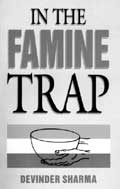Whither food security?
 RELEASED at the Food Summit in Rome in November 1996, the book presents a disturbing account of India's agricultural production status and mismanagement of resources by the government.
RELEASED at the Food Summit in Rome in November 1996, the book presents a disturbing account of India's agricultural production status and mismanagement of resources by the government.
The book, which gives a historical account of agricultural production in India till date, focuses on the faulty planning and practices which are still being promoted. These, it says, has resulted in us now being faced with the added burden of environmental degradation and declining productivity.
In support of these claims, the author has highlighted how rising water tables, waterlogging and the resulting soil salinity, a legacy of the mega-irrigation canals, have turned prime agricultural lands barren. He lampoons the ministry of agriculture for ignoring the traditional water conservation strategies followed for centuries in Rajasthan and Himachal Pradesh, and promoting the unaffordable energy intensive drip-irrigation.
Another issue discussed in the book is the lopsided food distribution policies because of which there are 320 million severely malnourished people in India. Sharma holds that the artificial self-sufficiency in food, reflected by the overflowing silos, is because the majority of the people lack economic access. In comparison, as much as 70 to 80 per cent of the food grains exported from India is used as cattle feed in the West.
The author holds the pricing policy responsible for agriculture no longer being economically attractive to the farmer, who then migrates to the city to earn more. Consequently, cities are expanding at a furious pace and eating into prime agricultural land.
Lending for agriculture by both private and public banks is also declining in favour of small-scale units. Statistics provided by Sharma say it all. The future appears bleak as economists have begun to feel that self-sufficiency in food is a costly proposition. He predicts increased dependence on the West for the supply of food grains as one of the effects of globalisation of agriculture.
For sceptics who find the book too pessimistic and the figures exaggerated, government reports of a decline in food production and the admission that agriculture has not been given its due importance in the Approach Paper to the Ninth Plan should be enough.
Though the book tends to get repetitive and appears disjointed at places, it should be of help to agricultural scientists, researchers, environmentalists and policy makers.The book would have benefited from a more detailed portrayal of possible solutions and workable models for sustainable agriculture. The only solution provided by Sharma is the Palamau model of the Chakriya Vikas Pranali, whereby a part of the income generated is shared between the landowners and the landless workers and the rest is used for village development and the village welfare fund.
